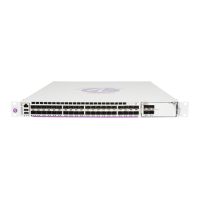Initializing and Provisioning
7705 SAR-A Chassis Installation Guide 111
Automatic Discovery Protocol
Automatic Discovery Protocol (ADP) is a factory-installed boot option that automates the
initial commissioning of 7705 SAR-A nodes. When the 7705 SAR-A is started for the first
time, an ADP keyword in the BOF causes automatic discovery to run as part of the TiMOS
application image.
In the console session, during the boot-up sequence, you can change the boot options before
the application image is loaded. On systems that support ADP, you will be presented with the
following additional options:
• enable/disable ADP
• specify an optional identifier and optional VLAN
• modify the location where the newly discovered configuration will be stored
For more information about ADP and the BOF file, refer to the 7705 SAR OS Basic System
Configuration Guide, “Automatic Discovery Protocol”. While it is running, ADP can be
controlled through the CLI.
When run on the system, ADP goes through four basic stages:
• Self-discovery
• Network discovery
• Configuration discovery
• Test and commit
If ADP encounters errors during one of the discovery stages, it enters a halted state until the
errors are cleared. ADP can detect some cleared errors and will continue processing. For other
cleared errors, you must give ADP a command to retry through the CLI. This causes ADP to
clear the rejected DHCP server list for all ports and retry any processing that failed. If still in
a halted state after 15 min, ADP times out and reboots the system. During the reboot, ADP
will attempt to run again.
ADP runs in the background to allow continued CLI access for status queries and
troubleshooting. Periodic progress updates are sent to the console and can be viewed through
a connected PC. Additionally, dump commands are available to display information and
detailed logs about ADP during and after running on the system. The logs are not retained
over a chassis reboot.
Caution: Automatic discovery will not run successfully on the 7705 SAR-A if the only
connection to the network is made from ports 1A to 1A and 1B to 4B.

